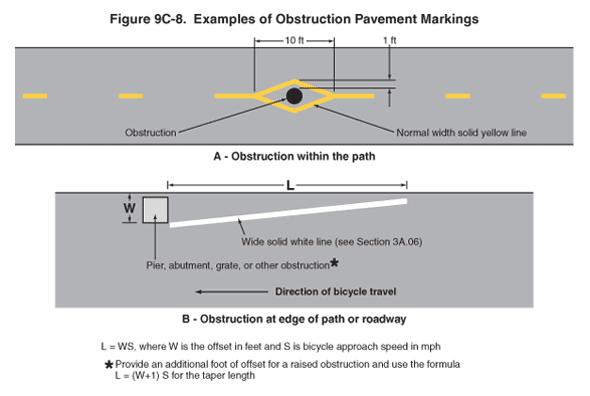2009 Edition Part 9 Figure 9C-8. Examples of Obstruction Pavement Marking

Figure 9C-8. Examples of Obstruction Pavement Marking
This figure illustrates two examples of obstruction pavement marking, labeled A and B.
A is labeled "Obstruction within the path." It shows a horizontal two-lane shared-use path with a circular obstruction in the center of the path between the two lanes. At the leftmost and rightmost sides of the illustration, a normal broken yellow line is shown marked on the pavement, separating the two lanes. Closer to the obstruction, both east and west of the obstruction, the broken yellow line is shown changing to a normal width solid yellow line. Closest to the obstruction, the obstruction is shown as being in the middle of a diamond-shaped island formed by solid yellow lines. The horizontal length of the diamond shape around the obstruction is shown as a dimension of 10 ft, and the vertical dimension from the edge of the obstruction to the outer edge of the yellow line at both of the vertically aligned points of the diamond shaped island is shown as 1 ft.
B is labeled "Obstruction at edge of path or roadway." It shows a section of a horizontal roadway. A black arrow shows that the direction of bicycle travel is from right to left. At the top left side of the figure, a square obstruction is shown occupying most of the top half of the pavement width and is labeled a "pier, abutment, grate, or other obstruction." A note states "Provide an additional foot of offset for a raised obstraction and use the formula L = (W + 1) S for the taper length."
To the right and in advance of the obstruction, a wide solid white line is shown marked on the pavement. A note states "See Section 3A.06." The solid white line is shown slanting from the top edge of the pavement on the right to the lower edge of the obstruction on the left. The horizontal length of the white line is labeled "L," and the dimension from the top edge of the pavement to the lowest edge of the obstruction is labeled "W."
A note states:
L = WS, where W is the offset in feet and S is bicycle approach speed in mph.
